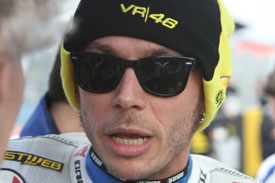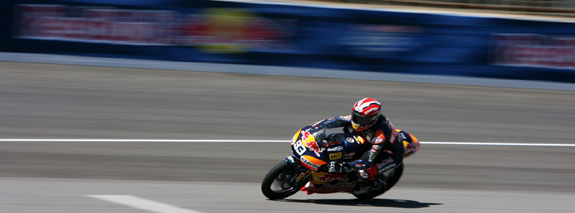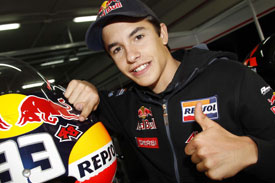Created with the single-minded goal of being simply the best on the track and on the road, since its inception the
Aprilia RSV4 has astonished the world with its looks, technology and performance.
The first 65° V-4 engine ever in a sports production bike, a chassis
worthy of a 250 GP, Ride By Wire, multimap engine management: all these
are accomplished achievements for the
Aprilia RSV4, that tops unique architecture and specs with Aprilia’s signature excellent rideability brought to the next level.
But records are made to be broken. Thanks to the unrelenting efforts of the
Aprilia R&D department and a very close collaboration between Racing Department and production, the Aprilia RSV4 has made a giant leap forward.
The
RSV4 Factory APRC is a milestone in the history
of super sport bikes. All of the racing expertise and indications
gathered during the successful 2010 season of World Champion Max Biaggi
were brought together in a bike that sets a new standard for future road
bike development.
Unique adjustable traction control capable of self-adjusting to suit
different types of tyres, wheelie control, launch control, quick shift:
these are the RSV4 Factory
APRC’s new features that raise the bar in track performance even further up.
Aprilia’s technological supremacy meant that every
aspect of the electronic management system for the RSV4 Factory SBK,
with which Max Biaggi dominated the 2010 World Superbike Championship,
could be developed in house. As a result of the innovative know how
developed on the circuit and the close collaboration between the team,
the Racing Division and the manufacturing division, the transfer of this
technology from the track to production was practically instantaneous.
This is how the Aprilia people were able to turn out the fastest, most
effective bike on the track, a bike whose only goal is to post the
fastest lap.
State of art technology
This new technology is brought together in the
APRC (Aprilia Performance Ride Control)
package, basically the state of the art in dynamic performance control,
a multi-patented system that makes Superbike winning technology
available to professional racing riders and hobby riders alike. All this
comes in an easy to use, intuitive package.
Aprilia RSV4 Factory APRC’s improvements are not limited to the
electronic management system. The 65° V4 engine offers improved
lubrication and closer spaced gears for better acceleration. The new,
lighter exhaust features an advanced butterfly valve management system
to suit the Ride By Wire mapping for improved breathing and efficiency
throughout the RPM range.
In addition, the Aprilia RSV4 Factory APRC is the first super sport
bike sporting the homologated new-generation extra performance dual
blend 200/55 tyres developed in collaboration with Pirelli based on the
expertise gathered on World Superbike racing circuits.
All of the innovations on the Factory APRC
The new features introduced in the Aprilia RSV4 Factory APRC in detail:
APRC Aprilia Performance Ride Control, the electronic management package including:
- ATC: Aprilia Traction Control automatically adjusts to different types
of tyres, with 8 settings conveniently selectable while racing from a
joystick on the left handlebar without turning down the throttle;
- AWC: Aprilia Wheelie Control with three settings;
- ALC: Aprilia Launch Control, for use on the track only, with 3 settings;
- AQS: Aprilia Quick Shift, for ultra-fast shifting without closing the throttle or using the clutch.
Dual display mode for instrument panel display: ROAD and RACE;
New exhaust is lighter and offers improved performance;
Optimised gear ratios for the utmost track performance;
Improved engine lubrication;
New, exclusive 200/55 dual blend rear tyre.
APRC APRILIA PERFORMANCE RIDE CONTROL
This is the most significant among the new features of the Aprilia
RSV4 Factory APRC, a technology platform that is one step above any
other systems available in the market, not yet available on all racing
bikes. The transfer of know-how from racing to production has resulted
in an electronic management system that is extremely sophisticated but
also intuitive and very user friendly.
The APRC package uses an automotive inertial sensor platform with two
gyrometers and two accelerometers allowing the ECU to recognise the
dynamic conditions of the bike and adapt the engine management
parameters accordingly. The rider can adjust any component of the APRC
system independently at will.
ATC: the traction control system of the future
The ATC- Aprilia Traction Control undoubtedly is one of the greatest
strengths of the APRC package. This is a fully innovative traction
control system developed from an Aprilia patent, mainly focussed on
helping the rider improve his lap times. Thanks to the inertial platform
and the Ride By Wire pioneered by Aprilia, the ATC not only reduces
torque when the rear wheel slips but lets the rider control tail sliding
when exiting a bend, giving him a better feel for throttle control,
depending on lean angle.
Aprilia ATC is quickly, easily activated from the instrument panel menu
and offers 8 settings. When the ATC is enabled, the rider can change
setting in an instant at any time using a joystick on the left handlebar
to suit track, pavement or tyre conditions, without closing the
throttle and keeping his hands on the handlebar, as in professional
motorcycle racing. This way, the system can adjust to every single bend
of any track so as to meet the specific requirements of any rider,
including the most expert ones.
The other incredible achievement of Aprilia technology is the system’s
“learning capacity”. Current traction control systems are designed and
optimised for a single size and type of tyre. This limit frequently
cancels the benefits of traction control. Aprilia Traction Control (ATC)
has overcome this limit: a procedure activated by the rider enables the
system to learn the tyre radius and final ratio adopted on the bike to
obtain fine-tuned traction control.
AWC: stability at top acceleration
Exploiting the full power of modern superbikes down to the very last HP
is every rider’s dream. Aprilia’s AWC (Aprilia Wheelie Control) has
achieved extraordinary results. Thanks to the exclusive Aprilia patented
Wheelie Detection System, the AWC is able to “tell” when a wheelie
begins and ends and kicks in to smoothen wheel contact with the road.
Smooth, soft wheelie management avoids harsh power cuts or pick-up,
providing perfect acceleration control. Again, the AWC system is
activated from the instrument panel and can be adjusted independently
from other control systems choosing from three settings to better meet
rider requirements.
ALC: the best holeshot
The perfect start is yet another racer’s dream, because a good start
frequently means you’re half way towards a victory. When the lights go
out, handling the huge power of modern superbikes is no easy task.
Unless the bike handles it itself to offer its best starting
performance. The ALC (Aprilia Launch Control) system ensures an instant
start as the lights go out, applying full power to the road to assist
the rider in this critical moment of the race. All the rider needs to do
is give full throttle and release the clutch as he normally would and
shift gears. The ALC has three settings that can be selected from the
instrument panel menu, then it must be “armed” at standstill, by
squeezing both traction control buttons on the left handlebar joystick
at the same time.
AQS: record-breaking shifting
When you’re after the utmost lap performance, you can’t afford to waste
even one thousandth of a second in an apparently simple operation like
shifting. RSV4 Factory APRC is the first Aprilia bike that comes with
the Aprilia Quick Shift as standard. Basically, the quick shift shortens
spark advance for an instant and then gradually restores it, making for
super-fast shifting with no need to close the throttle or use the
clutch. The system works hand in hand with the new closer spaced gearbox
to limit RPM drop during shifting for faster lap times. To optimise AQS
performance, Aprilia engineers have fine-tuned power cut timing based
on shifting RPM.
THE MOTORCYCLE
A combination of superior mechanical and electronic technologies can
only lead to excellent rideability. “Factory” is the key word that
evokes the world of racing and special bikes, for special riders who
demand top sport riding performance. Prestigious materials, an
ultra-sophisticated suspension and the APRC system make the RSV4 Factory
APRC quite simply the most advanced and highest performance sports bike
on the track.
The RSV4 Factory APRC aims to be the perfect tool for riders who
demand top track performance from their bikes. Sophisticated, valuable,
refined – this bike is the best in motorcycling technology worldwide. In
addition to the structural and mechanical refinement of the RSV4
Factory – in this MY2011 – we have prestigious materials, modifications
to make it lighter and increase engine performance, and the APRC package
which allows dynamic management of the bike on a professional level
with an easy and intuitive interface.
This project is designed for those who want top riding performance on
the track at a price/equipment ratio unequalled in its class.
RSV4 Factory APRC is the RSV4 at the nth power, direct descendent of the World Superbike winner.
RSV4 Factory APRC highlights:
• APRC fitted as standard
• Fuel system with variable length intake ducts
• Advanced exhaust butterfly valve management
• 3-point adjustable chassis
• Öhlins fully adjustable front fork
• Öhlins fully adjustable shock absorber
• Öhlins adjustable steering damper
• Wheel rims in forged aluminium
• Carbon parts
THE ENGINE
While the incredible APRC system is without a doubt the most
important new feature introduced with this latest version of the RSV4,
there has also been a raft of significant updates made to the engine of
the RSV4 Factory APRC, drawn from experience in competion to improve its
already legendary technical and mechanical characteristics.
Aprilia RSV4 is the only production super sport bike using a narrow
65° V four-cylinder engine with unique features. Extremely compact, as
slim as a twin-cylinder to fit in an ultra-compact chassis, the 65° V4
engine was and still is the epitome of Italian engineering ingenuity.
The Aprilia 65° V4 engine specifications in short:
Engine capacity: 999.6 cc
Architecture: 65° V4
Crankcase: monobloc with integrated crankcase liners
Timing system: 4 valves per cylinder (Titanium and Nymonic) operated
directly by a camshaft driven by a mixed chain/gear system, lateral
timing chain, central gear train
Fuel system: Electronic injection with 2 injectors per cylinder and
integrated independent Ride by Wire system for each bank. Three mappings
selectable from handlebar.
Antivibration countershaft
Compression ratio: 13:1
Transmission: 6-speed direct-control cassette type gearbox
Clutch: Multiplate wet clutch with mechanical slipper system
Electronic management: Magneti Marelli control unit managing ignition,
injection and Ride by Wire system, and variable length intake ducts
APRC system for dynamic control
The narrow V architecture translates into an engine that is
incredibly compact in length, offering advantages in terms of mass
centralisation and an extremely high performance chassis (short
wheelbase, long swingarm).
The innovative timing system (with the chain camshaft driving only the
intake camshaft, which in turn drives the exhaust camshaft via a gear)
has made extremely compact heads (just 250 mm at the rear of the engine)
especially in the area beneath the frame spars, which are thus much
narrower than would otherwise be possible.
A countershaft dampens vibrations even more than in a 90° V engine.
The monobloc crankcase with integrated aluminium cylinder liners ensures maximum rigidity and consistent performance.
The electronic management system is another example of the 65° V4
engine’s technological supremacy. Full Ride-by-Wire technology
eliminates any direct connection between the throttle grip and the
throttle valves, which are entirely controlled by a latest generation
Marelli control unit that also controls the ignition and the 8 injectors
(the 4 secondary fan pattern injectors come into play at high loads).
Each bank has a dedicated servo unit actuating its own two throttle
bodies only. This means that the aperture of the throttle valves and, as
a consequence, the quantity of fuel injected, can be controlled
independently. This solution, applied here for the first time ever in a
production bike, opens up practically infinite possibilities for power
delivery control and works hand in hand with the APRC system.
The transmission has also been designed to the meet most advanced
criteria to offer the maximum performance possible. To underscore the
racing soul of the 65° V4 engine, it is mated to a cassette gearbox with
a wet sump lubrication system (with oil in the crankcase). The wet
clutch features a mechanical slipper system for optimised engine braking
torque control and stability under hard braking.
The 65° V4 was one of the most advanced engines in the world at the
time of its debut. The new RSV4 Factory APRC underwent a number of
refinements and further improvements based on the world superbike racing
experience with the factory bike. The new exhaust and engine mappings
make for optimal power delivery. Lubrication has been improved at
critical points, the countershaft runs in ball bearings rather than
plain bushings and the head cooling circuit has been reviewed for
optimal operating temperatures and long-term reliability.
Combustion chambers and cylinder-piston fits have also been revised for
optimal engine performance. The three lowest gears are spaced closer for
extra speed out of bends. The advanced exhaust butterfly valve
management system improved delivery in the low rpm band and reduces
emissions while preserving the engine’s thrilling sound.
CHASSIS
The bike retains the unique chassis and swingarm solutions that make
it the world’s first “race ready” V4 superbike. In order to boost
chassis performance and make it match the rider’s tastes, or features of
the track, Aprilia RSV4 Factory ensures a combination of adjustments
that are pretty much infinite. The multi-adjustable suspension, taken
for granted on a motorcycle of this level, are combined with three
chassis adjustments: headstock position and rake (through
interchangeable bushings), rear end height, swingarm pin height and the
engine position in the frame.
Suspension
The Öhlins Racing upside-down fork has 43-mm diameter stanchions and is
titanium nitride coated to minimise friction. The wheel travel is 120
mm. As on a racing bike, the fork allows millimetre-precise adjustment
for hydraulic compression and rebound damping and spring preload.
The Öhlins Racing rear shock absorber was developed from experience
learned directly on the track. It features a piggy back nitrogen
canister (separate and mounted on the body of the unit) and adjustable
spring preload, compression and rebound damping and length, allowing the
height of the rear end of the bike to be altered to modify the set-up
to suit different riding styles and tracks. Wheel travel is 130 mm.
Wheels and tyres
The effort to shed as much weight as possible and offer the best feeling
led to implementation of new, ultra-light forged aluminium rims.An
almost obsessive pursuit of top performance resulted in an exclusive,
innovative dual blend tyre developed in collaboration with Racing
Department, R&D and Pirelli. The racing sized 200/55 ZR17 tyre
offers a better contact pattern in bends, shaving precious tenths of a
second of lap time – a technology unique to this bike.
Componentry
A real Superbike is special not only as far as performance is concerned
but also for the care it is built with. With regard to the RSV4 Factory
APRC, the details say it all: no other “race ready” motorcycle has ever
been built with such care and attention. The attention paid to its
construction not only satisfies the desire for beauty. A motorbike built
like the RSV4 Factory APRC is in any case gorgeous, but most of all
aims at achieving the goal: to win. This is why every detail was thought
out to increase performance and functionality, reducing the weight and
considerably increasing the product’s quality and finish.
The livery is impressed on the contrast between red and black, the
Aprilia
sports colours, with a third “nuance” represented by the visible carbon
fibre theme generously distributed on this precious Factory APRC
version.
Interesting to read please now




 Now, not since 1997 have I given so much time during a season to
ferreting around a 125 team's garage while on my paddock wanderings.
It's the Finnish-run Ajo Motorsport garage with Marc Marquez and the
super-nice German-with-the-Italian name, Sandro Cortese that I've
visited. There are some great guys in the garage from all over Europe -
Finns, Germans and Spaniards. Young guys, old guys, new guys,
race-winning mechanics and a world champion with Emilio Alzamora who's
trying to 'win it' all over again with Marc, some 11 years after he won
it himself at Buenos Aires in 2012.
Now, not since 1997 have I given so much time during a season to
ferreting around a 125 team's garage while on my paddock wanderings.
It's the Finnish-run Ajo Motorsport garage with Marc Marquez and the
super-nice German-with-the-Italian name, Sandro Cortese that I've
visited. There are some great guys in the garage from all over Europe -
Finns, Germans and Spaniards. Young guys, old guys, new guys,
race-winning mechanics and a world champion with Emilio Alzamora who's
trying to 'win it' all over again with Marc, some 11 years after he won
it himself at Buenos Aires in 2012.
 The
beauty of the Monster line is that the basic architecture of the
bikes, including the chassis, air/oil-cooled V-Twin engine
configuration, and sleek minimalist body panels are shared between
models. However a closer look reveals there are some key differences
between this one and its siblings.
The
beauty of the Monster line is that the basic architecture of the
bikes, including the chassis, air/oil-cooled V-Twin engine
configuration, and sleek minimalist body panels are shared between
models. However a closer look reveals there are some key differences
between this one and its siblings.







